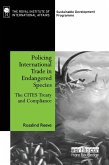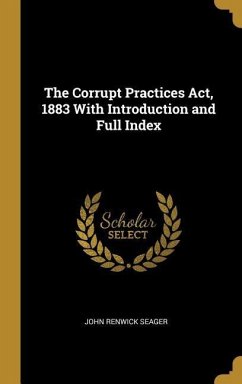Codex of the Endangered Species Act, Volume II
The Next Fifty Years
Herausgeber: Organ, John F; Baier, Lowell E
Codex of the Endangered Species Act, Volume II
The Next Fifty Years
Herausgeber: Organ, John F; Baier, Lowell E
- Gebundenes Buch
- Merkliste
- Auf die Merkliste
- Bewerten Bewerten
- Teilen
- Produkt teilen
- Produkterinnerung
- Produkterinnerung
The Endangered Species Act of 1973 (ESA) is one of the most cherished and reviled laws ever passed. It mandates protection and preservation of all the nation's species and biodiversity, whatever the cost. It has been a lightning rod for controversy and conflicts between industry/business and environmentalists. In this volume, leading Endangered Species Act experts interpret and propose legislative and administrative changes to prepare the ESA for future challenges. They explore regulations on avoiding harm to and producing benefits for species, cooperation between state and federal agencies,…mehr
Andere Kunden interessierten sich auch für
![Codex of the Endangered Species Act Codex of the Endangered Species Act]() Lowell E BaierCodex of the Endangered Species Act93,99 €
Lowell E BaierCodex of the Endangered Species Act93,99 €![Endangered Species and Fragile Ecosystems in the South China Sea Endangered Species and Fragile Ecosystems in the South China Sea]() Robles, Jr., Alfredo C.Endangered Species and Fragile Ecosystems in the South China Sea38,99 €
Robles, Jr., Alfredo C.Endangered Species and Fragile Ecosystems in the South China Sea38,99 €![Policing International Trade in Endangered Species Policing International Trade in Endangered Species]() Rosalind ReevePolicing International Trade in Endangered Species175,99 €
Rosalind ReevePolicing International Trade in Endangered Species175,99 €![Environmental Politics Environmental Politics]() Norman MillerEnvironmental Politics131,99 €
Norman MillerEnvironmental Politics131,99 €![Endangered Species and Fragile Ecosystems in the South China Sea Endangered Species and Fragile Ecosystems in the South China Sea]() Alfredo C. RoblesEndangered Species and Fragile Ecosystems in the South China Sea38,99 €
Alfredo C. RoblesEndangered Species and Fragile Ecosystems in the South China Sea38,99 €![Endangered Species Endangered Species]() Stephen M YoungerEndangered Species15,99 €
Stephen M YoungerEndangered Species15,99 €![The Corrupt Practices Act, 1883 With Introduction and Full Index The Corrupt Practices Act, 1883 With Introduction and Full Index]() John Renwick SeagerThe Corrupt Practices Act, 1883 With Introduction and Full Index28,99 €
John Renwick SeagerThe Corrupt Practices Act, 1883 With Introduction and Full Index28,99 €-
-
-
The Endangered Species Act of 1973 (ESA) is one of the most cherished and reviled laws ever passed. It mandates protection and preservation of all the nation's species and biodiversity, whatever the cost. It has been a lightning rod for controversy and conflicts between industry/business and environmentalists. In this volume, leading Endangered Species Act experts interpret and propose legislative and administrative changes to prepare the ESA for future challenges. They explore regulations on avoiding harm to and producing benefits for species, cooperation between state and federal agencies, scientific analyses, and the necessary politics to enact their ideas. This is a call to action to chart an enlightened future for the Endangered Species Act that embraces the nation's moral commitment of 50 years ago to address species extinction constructively, mindful of biodiversity, and as a fixture among the nation's values and needs. The interconnected web of life includes all living species that depend on each other for survival, us among them. The stakes-our very future-are too high to ignore.
Produktdetails
- Produktdetails
- Verlag: Bloomsbury Publishing PLC
- Seitenzahl: 368
- Erscheinungstermin: 20. Dezember 2023
- Englisch
- Abmessung: 257mm x 178mm x 33mm
- Gewicht: 839g
- ISBN-13: 9781538180143
- ISBN-10: 1538180146
- Artikelnr.: 68102088
- Herstellerkennzeichnung
- Libri GmbH
- Europaallee 1
- 36244 Bad Hersfeld
- gpsr@libri.de
- Verlag: Bloomsbury Publishing PLC
- Seitenzahl: 368
- Erscheinungstermin: 20. Dezember 2023
- Englisch
- Abmessung: 257mm x 178mm x 33mm
- Gewicht: 839g
- ISBN-13: 9781538180143
- ISBN-10: 1538180146
- Artikelnr.: 68102088
- Herstellerkennzeichnung
- Libri GmbH
- Europaallee 1
- 36244 Bad Hersfeld
- gpsr@libri.de
Lowell E. Baier is an attorney and a legal and environmental historian and author. He has worked in Washington, D.C. throughout his fifty-eight-year career as a tireless advocate for natural resources and wildlife conservation. John F. Organ is Chief of the Cooperative Fish and Wildlife Research Units and Senior Science Advisor for Cooperative Research for the U.S. Geological Survey.
Table of Contents
List of IllustrationsGuide to Acronyms and TermsForewordPrologueSummary of
14 ChaptersChapter 1: Species Recovery and State Wildlife Action Plans:
Moving the ESA from Regulation to Cooperation. John F. Organ,
Ph.D.IntroductionPremisesHistorical Perspective on the ESAGuiding
Principles for State Wildlife Action PlansState Wildlife Action Plans
TodayNew HopeChapter 2: Making an Asset of Endangered Species Recovery.
Timothy Male, Ph.D.Creating Predictable Offramps from New Reasonable and
Prudent Measures through a Net Conservation Benefit PlanCreating
Population-Level Deregulatory OpportunitiesFinancial Backing for Mitigation
Credit SuppliesFloor PriceWildlife Revolving Loan FundPay for Success
Recovery ContractingStandardizing a Baseline YearHow Would a Baseline Year
Work?Authorization of Private Landowner Payments for Hosting Listed
SpeciesConclusionsChapter 3: Unlocking the Full Power of Section 4(d) to
Facilitate Collaboration and Greater Species Recovery. David Willms,
J.D.History of 4(d) RulesThe 1975 Grizzly Bear 4(d) RuleThe Role of
Litigation in Species Delisting EffortsSocial Tolerance for Listed Species
in the Face of LitigationUsing Section 4(d) to Establish Benchmarks for
Incremental Delegation of Authority to StatesHypothetical GYA Grizzly Bear
4(d) Rule with Incremental Management Delegation to StatesChapter 4: Using
Practice-Based Regulations to Promote Collaborative Recovery of Threatened
Species. Robert L. Fischman, J.D.AbstractI. IntroductionII. The
Collaborative Governance Framework in ESA 4(d) RulesA. Substantive
Standards for Protective RegulationsB. Collaborative Governance
ManifestationsIII.A Comprehensive Evaluation of Protective RegulationsA.
Who and WhereB. WhyC. HowD. How Long: Review and RevisionIV.Lessons for
More Effective Collaborative Governance through Protective RegulationsA. A
Framework for Preparing RegulationsB. Cooperative FederalismC. Promoting
Recovery1. A Conservation Standard 2. Adaptive ManagementD. EnforcementE.
Delisting TrialsV.ConclusionChapter 5: The Species Status Assessment: A
Framework for Assessing Species Status and Risk to Support Endangered
Species Management Decisions. Conor McGowan, Ph.D., Nathan Allan, M.S., and
David R. Smith, Ph.D.IntroductionFraming the Problem and the Impetus for
the SSA FrameworkThe Decision ProblemDecision OpportunitiesThe Species
Status Assessment FrameworkSpecies NeedsCurrent ConditionsFuture
ConditionsThe Three R'sResiliencyRedundancyRepresentationSSAs in the
Decision ProcessFuture Challenges and OpportunitiesAcknowledgementsChapter
6: The Future of Habitat: Lessons From the Dusky Gopher Frog Conflict.
Jonathan Wood, J.D. and Tate Watkins, M.A.I. The ESA's Critical Habitat
ProvisionsII. A Shy Frog, Uninhabitable Critical Habitat, and Supreme
ConflictIII. Critical Habitat's "Private Land Problem"IV. Lessons for
Species Recovery From the Dusky Gopher Frog ConflictA. Is the Land Public
or Privately Owned?B. Is the Land Occupied or Unoccupied?C. Is the Land
Habitable or Does It Require Restoration Efforts?V. Turning Habitat From a
Liability into an AssetA. Repeal the Critical Habitat Provisions and Pursue
Habitat Conservation By Other MeansB. Purchase of Habitat or Potential
HabitatC. Incentives for Recovery EffortsD. Rewards for Provision of
Ecosystem ServicesVI. ConclusionChapter 7: The ESA and Landscape
Conservation: A Vision for the Future. Ken Elowe, Ph.D.Landscape
ConservationWhat Does this Have to Do with the ESA?An OpportunityDoes This
Work?A Conservation ImperativeThe Future of ConservationChapter 8:
Scenarios for the Next 50 Years. Gregory Schildwachter,
Ph.D.IntroductionPremisesBetter MeasuresA Model for Building
ScenariosInputsPolitical InputsScenario Element: Add Collaboration as a
Political InputTime and Money ResourcesScenario Element: Improved Measures
of InputsScenario Element: Additional Funds from the Private Sector as
InputsSummary of Scenario Elements for InputsActivitiesPolitical
ActivitiesScenario Element: Developing, Pitching, and Promoting Policy and
Program ProposalsAdministrative ActivitiesScenario Element: Directing
Activities by Priority and EfficiencyScenario Element: Using Saved Time and
Money for Other ActivitiesSummary of Scenario Elements for
ActivitiesOutputs and OutcomesScenario Element from Outputs: A More
Informative Box ScoreAdministrative and Political OutputsScenario Element
from Outputs: Higher Numbers of Timely ApprovalsScenario Element from
Outputs: An Agenda of Active Collaborative ProposalsSummary of Scenario
Elements for Outputs and OutcomesRearranging the ObviousScenario
OneScenario TwoScenario ThreeFinal ScenarioChapter 9: The Role of Genomics
in the Future of ESA Decision-Making. Brenna R. Forester, Ph.D. and Tanya
Lama, Ph.D.IntroductionThe Role of Genetics and Genomics in the ESA:
ListingTaxonomy and Classification StatusAssessing Current Conditions and
Relationships to Past ChangeAssessing Response to Future ConditionsThe Role
of Genetics and Genomics in the ESA: RecoveryDeveloping Recovery
UnitsIdentifying Recovery CriteriaIdentifying Recovery ActionsMonitoring
RecoveryFrontiers in Conservation Genomics & the Next Fifty
YearsAcknowledgementsChapter 10: The Future of Section 10 - Multiple
Species Habitat Conservation Plans? Douglas P. Wheeler, J.D. and Dale
Ratliff, J.D.IntroductionThe Early ESA and Enactment of Section 10A.1982
ESA AmendmentB.The "No Surprises" RuleLarge-Scale, Multispecies HCPs:
Taking Stock of the Western Riverside MSHCP as a National
ModelA.Background: The Western Riverside County Multiple-Species
HCPB.Habitat Acquisition under the Western Riverside MSHCPC.Project
Efficiency and Cost Savings: A Successful Model for Supporting Needed
InfrastructureD.Lessons Learned: Multi-Agency Wetland Permitting1. The
Western Placer County Habitat Conservation Plan and Natural Community
Conservation Plan2. Increased Coordination in Administration of the Western
Riverside MSHCPThe Future of MSHCPS: Multi-Species and Multi-States HCPs
for Renewable and Transmission ProjectsA.The Midwest Wind Energy
Multi-Species HCP1. Resource Equivalency Analysis and Evidence of Absence2.
The Midwest Short-Term TemplateB.The R-Project HCPC.Renewable Energy HCP
for the Lesser Prairie-ChickenFuture DirectionsA.Increased Inventory
Efforts and Focus on Biological Hot SpotsB.Better Funding Mechanisms to
Create Certainty and Promote Advanced ImplementationC.Increased Efficiency
in Development and ApprovalsD.MSHCPs and RecoveryConclusionChapter 11:
Improving cooperative state and federal species conservation efforts.
Temple Stoellinger, J.D., Michael Brennan, J.D., Sara Brodnax, MEM, Ya-Wei
(Jake) Li, J.D., Murray Feldman, J.D., and Bob Budd, M.S.I. IntroductionII.
BackgroundIII. The WorkshopSection 1: State-Led ConservationSection 2:
Pre-Listing ConservationSection 3: Enhancing Opportunities for State
Science and State Participation in Species Status Assessment
PreparationSection 4: Expand Opportunities for States to Help Develop and
Implement 4(d) Rules for Threatened SpeciesSection 5: Communication
Principles for States and the FWSSection 6: Recovery Planning and
Implementation and DelistingSection 7: Funding Needs for Conservation of
All SpeciesIV. ConclusionChapter 12: Integrating Social and Environmental
Science in Decision Making for Endangered Species Management. Shawn J.
Riley, Ph.D. and Angela K. Fuller, Ph.D.Decisions and the ESASome Basic
Social Science for Decision Aiding in Endangered Species ManagementThe
National Environmental Policy Act and the Endangered Species ActDecision
Making under NEPA and Parallels to Structured Decision Making and Adaptive
Management FrameworksSynthesis and Future DirectionsChapter 13:
Conservation Without Conflict: A Collaborative Approach to the Endangered
Species Act. James F. Bullock, Jr., M.S., and Cindy K. Dohner,
M.S.Foundation for Collaborative ConservationThe Black Bear Conservation
CommitteeConservation Without ConflictSidebar: Conservation Without
Conflict Operating PrinciplesChapter 14: The Endangered Species Act: The
Next Fifty Years. Lowell E. Baier, J.D., John F. Organ, Ph.D., and
Christopher E. Segal, J.D.AcknowledgementsBibliography IndexAbout the
Contributors
List of IllustrationsGuide to Acronyms and TermsForewordPrologueSummary of
14 ChaptersChapter 1: Species Recovery and State Wildlife Action Plans:
Moving the ESA from Regulation to Cooperation. John F. Organ,
Ph.D.IntroductionPremisesHistorical Perspective on the ESAGuiding
Principles for State Wildlife Action PlansState Wildlife Action Plans
TodayNew HopeChapter 2: Making an Asset of Endangered Species Recovery.
Timothy Male, Ph.D.Creating Predictable Offramps from New Reasonable and
Prudent Measures through a Net Conservation Benefit PlanCreating
Population-Level Deregulatory OpportunitiesFinancial Backing for Mitigation
Credit SuppliesFloor PriceWildlife Revolving Loan FundPay for Success
Recovery ContractingStandardizing a Baseline YearHow Would a Baseline Year
Work?Authorization of Private Landowner Payments for Hosting Listed
SpeciesConclusionsChapter 3: Unlocking the Full Power of Section 4(d) to
Facilitate Collaboration and Greater Species Recovery. David Willms,
J.D.History of 4(d) RulesThe 1975 Grizzly Bear 4(d) RuleThe Role of
Litigation in Species Delisting EffortsSocial Tolerance for Listed Species
in the Face of LitigationUsing Section 4(d) to Establish Benchmarks for
Incremental Delegation of Authority to StatesHypothetical GYA Grizzly Bear
4(d) Rule with Incremental Management Delegation to StatesChapter 4: Using
Practice-Based Regulations to Promote Collaborative Recovery of Threatened
Species. Robert L. Fischman, J.D.AbstractI. IntroductionII. The
Collaborative Governance Framework in ESA 4(d) RulesA. Substantive
Standards for Protective RegulationsB. Collaborative Governance
ManifestationsIII.A Comprehensive Evaluation of Protective RegulationsA.
Who and WhereB. WhyC. HowD. How Long: Review and RevisionIV.Lessons for
More Effective Collaborative Governance through Protective RegulationsA. A
Framework for Preparing RegulationsB. Cooperative FederalismC. Promoting
Recovery1. A Conservation Standard 2. Adaptive ManagementD. EnforcementE.
Delisting TrialsV.ConclusionChapter 5: The Species Status Assessment: A
Framework for Assessing Species Status and Risk to Support Endangered
Species Management Decisions. Conor McGowan, Ph.D., Nathan Allan, M.S., and
David R. Smith, Ph.D.IntroductionFraming the Problem and the Impetus for
the SSA FrameworkThe Decision ProblemDecision OpportunitiesThe Species
Status Assessment FrameworkSpecies NeedsCurrent ConditionsFuture
ConditionsThe Three R'sResiliencyRedundancyRepresentationSSAs in the
Decision ProcessFuture Challenges and OpportunitiesAcknowledgementsChapter
6: The Future of Habitat: Lessons From the Dusky Gopher Frog Conflict.
Jonathan Wood, J.D. and Tate Watkins, M.A.I. The ESA's Critical Habitat
ProvisionsII. A Shy Frog, Uninhabitable Critical Habitat, and Supreme
ConflictIII. Critical Habitat's "Private Land Problem"IV. Lessons for
Species Recovery From the Dusky Gopher Frog ConflictA. Is the Land Public
or Privately Owned?B. Is the Land Occupied or Unoccupied?C. Is the Land
Habitable or Does It Require Restoration Efforts?V. Turning Habitat From a
Liability into an AssetA. Repeal the Critical Habitat Provisions and Pursue
Habitat Conservation By Other MeansB. Purchase of Habitat or Potential
HabitatC. Incentives for Recovery EffortsD. Rewards for Provision of
Ecosystem ServicesVI. ConclusionChapter 7: The ESA and Landscape
Conservation: A Vision for the Future. Ken Elowe, Ph.D.Landscape
ConservationWhat Does this Have to Do with the ESA?An OpportunityDoes This
Work?A Conservation ImperativeThe Future of ConservationChapter 8:
Scenarios for the Next 50 Years. Gregory Schildwachter,
Ph.D.IntroductionPremisesBetter MeasuresA Model for Building
ScenariosInputsPolitical InputsScenario Element: Add Collaboration as a
Political InputTime and Money ResourcesScenario Element: Improved Measures
of InputsScenario Element: Additional Funds from the Private Sector as
InputsSummary of Scenario Elements for InputsActivitiesPolitical
ActivitiesScenario Element: Developing, Pitching, and Promoting Policy and
Program ProposalsAdministrative ActivitiesScenario Element: Directing
Activities by Priority and EfficiencyScenario Element: Using Saved Time and
Money for Other ActivitiesSummary of Scenario Elements for
ActivitiesOutputs and OutcomesScenario Element from Outputs: A More
Informative Box ScoreAdministrative and Political OutputsScenario Element
from Outputs: Higher Numbers of Timely ApprovalsScenario Element from
Outputs: An Agenda of Active Collaborative ProposalsSummary of Scenario
Elements for Outputs and OutcomesRearranging the ObviousScenario
OneScenario TwoScenario ThreeFinal ScenarioChapter 9: The Role of Genomics
in the Future of ESA Decision-Making. Brenna R. Forester, Ph.D. and Tanya
Lama, Ph.D.IntroductionThe Role of Genetics and Genomics in the ESA:
ListingTaxonomy and Classification StatusAssessing Current Conditions and
Relationships to Past ChangeAssessing Response to Future ConditionsThe Role
of Genetics and Genomics in the ESA: RecoveryDeveloping Recovery
UnitsIdentifying Recovery CriteriaIdentifying Recovery ActionsMonitoring
RecoveryFrontiers in Conservation Genomics & the Next Fifty
YearsAcknowledgementsChapter 10: The Future of Section 10 - Multiple
Species Habitat Conservation Plans? Douglas P. Wheeler, J.D. and Dale
Ratliff, J.D.IntroductionThe Early ESA and Enactment of Section 10A.1982
ESA AmendmentB.The "No Surprises" RuleLarge-Scale, Multispecies HCPs:
Taking Stock of the Western Riverside MSHCP as a National
ModelA.Background: The Western Riverside County Multiple-Species
HCPB.Habitat Acquisition under the Western Riverside MSHCPC.Project
Efficiency and Cost Savings: A Successful Model for Supporting Needed
InfrastructureD.Lessons Learned: Multi-Agency Wetland Permitting1. The
Western Placer County Habitat Conservation Plan and Natural Community
Conservation Plan2. Increased Coordination in Administration of the Western
Riverside MSHCPThe Future of MSHCPS: Multi-Species and Multi-States HCPs
for Renewable and Transmission ProjectsA.The Midwest Wind Energy
Multi-Species HCP1. Resource Equivalency Analysis and Evidence of Absence2.
The Midwest Short-Term TemplateB.The R-Project HCPC.Renewable Energy HCP
for the Lesser Prairie-ChickenFuture DirectionsA.Increased Inventory
Efforts and Focus on Biological Hot SpotsB.Better Funding Mechanisms to
Create Certainty and Promote Advanced ImplementationC.Increased Efficiency
in Development and ApprovalsD.MSHCPs and RecoveryConclusionChapter 11:
Improving cooperative state and federal species conservation efforts.
Temple Stoellinger, J.D., Michael Brennan, J.D., Sara Brodnax, MEM, Ya-Wei
(Jake) Li, J.D., Murray Feldman, J.D., and Bob Budd, M.S.I. IntroductionII.
BackgroundIII. The WorkshopSection 1: State-Led ConservationSection 2:
Pre-Listing ConservationSection 3: Enhancing Opportunities for State
Science and State Participation in Species Status Assessment
PreparationSection 4: Expand Opportunities for States to Help Develop and
Implement 4(d) Rules for Threatened SpeciesSection 5: Communication
Principles for States and the FWSSection 6: Recovery Planning and
Implementation and DelistingSection 7: Funding Needs for Conservation of
All SpeciesIV. ConclusionChapter 12: Integrating Social and Environmental
Science in Decision Making for Endangered Species Management. Shawn J.
Riley, Ph.D. and Angela K. Fuller, Ph.D.Decisions and the ESASome Basic
Social Science for Decision Aiding in Endangered Species ManagementThe
National Environmental Policy Act and the Endangered Species ActDecision
Making under NEPA and Parallels to Structured Decision Making and Adaptive
Management FrameworksSynthesis and Future DirectionsChapter 13:
Conservation Without Conflict: A Collaborative Approach to the Endangered
Species Act. James F. Bullock, Jr., M.S., and Cindy K. Dohner,
M.S.Foundation for Collaborative ConservationThe Black Bear Conservation
CommitteeConservation Without ConflictSidebar: Conservation Without
Conflict Operating PrinciplesChapter 14: The Endangered Species Act: The
Next Fifty Years. Lowell E. Baier, J.D., John F. Organ, Ph.D., and
Christopher E. Segal, J.D.AcknowledgementsBibliography IndexAbout the
Contributors
Table of Contents
List of IllustrationsGuide to Acronyms and TermsForewordPrologueSummary of
14 ChaptersChapter 1: Species Recovery and State Wildlife Action Plans:
Moving the ESA from Regulation to Cooperation. John F. Organ,
Ph.D.IntroductionPremisesHistorical Perspective on the ESAGuiding
Principles for State Wildlife Action PlansState Wildlife Action Plans
TodayNew HopeChapter 2: Making an Asset of Endangered Species Recovery.
Timothy Male, Ph.D.Creating Predictable Offramps from New Reasonable and
Prudent Measures through a Net Conservation Benefit PlanCreating
Population-Level Deregulatory OpportunitiesFinancial Backing for Mitigation
Credit SuppliesFloor PriceWildlife Revolving Loan FundPay for Success
Recovery ContractingStandardizing a Baseline YearHow Would a Baseline Year
Work?Authorization of Private Landowner Payments for Hosting Listed
SpeciesConclusionsChapter 3: Unlocking the Full Power of Section 4(d) to
Facilitate Collaboration and Greater Species Recovery. David Willms,
J.D.History of 4(d) RulesThe 1975 Grizzly Bear 4(d) RuleThe Role of
Litigation in Species Delisting EffortsSocial Tolerance for Listed Species
in the Face of LitigationUsing Section 4(d) to Establish Benchmarks for
Incremental Delegation of Authority to StatesHypothetical GYA Grizzly Bear
4(d) Rule with Incremental Management Delegation to StatesChapter 4: Using
Practice-Based Regulations to Promote Collaborative Recovery of Threatened
Species. Robert L. Fischman, J.D.AbstractI. IntroductionII. The
Collaborative Governance Framework in ESA 4(d) RulesA. Substantive
Standards for Protective RegulationsB. Collaborative Governance
ManifestationsIII.A Comprehensive Evaluation of Protective RegulationsA.
Who and WhereB. WhyC. HowD. How Long: Review and RevisionIV.Lessons for
More Effective Collaborative Governance through Protective RegulationsA. A
Framework for Preparing RegulationsB. Cooperative FederalismC. Promoting
Recovery1. A Conservation Standard 2. Adaptive ManagementD. EnforcementE.
Delisting TrialsV.ConclusionChapter 5: The Species Status Assessment: A
Framework for Assessing Species Status and Risk to Support Endangered
Species Management Decisions. Conor McGowan, Ph.D., Nathan Allan, M.S., and
David R. Smith, Ph.D.IntroductionFraming the Problem and the Impetus for
the SSA FrameworkThe Decision ProblemDecision OpportunitiesThe Species
Status Assessment FrameworkSpecies NeedsCurrent ConditionsFuture
ConditionsThe Three R'sResiliencyRedundancyRepresentationSSAs in the
Decision ProcessFuture Challenges and OpportunitiesAcknowledgementsChapter
6: The Future of Habitat: Lessons From the Dusky Gopher Frog Conflict.
Jonathan Wood, J.D. and Tate Watkins, M.A.I. The ESA's Critical Habitat
ProvisionsII. A Shy Frog, Uninhabitable Critical Habitat, and Supreme
ConflictIII. Critical Habitat's "Private Land Problem"IV. Lessons for
Species Recovery From the Dusky Gopher Frog ConflictA. Is the Land Public
or Privately Owned?B. Is the Land Occupied or Unoccupied?C. Is the Land
Habitable or Does It Require Restoration Efforts?V. Turning Habitat From a
Liability into an AssetA. Repeal the Critical Habitat Provisions and Pursue
Habitat Conservation By Other MeansB. Purchase of Habitat or Potential
HabitatC. Incentives for Recovery EffortsD. Rewards for Provision of
Ecosystem ServicesVI. ConclusionChapter 7: The ESA and Landscape
Conservation: A Vision for the Future. Ken Elowe, Ph.D.Landscape
ConservationWhat Does this Have to Do with the ESA?An OpportunityDoes This
Work?A Conservation ImperativeThe Future of ConservationChapter 8:
Scenarios for the Next 50 Years. Gregory Schildwachter,
Ph.D.IntroductionPremisesBetter MeasuresA Model for Building
ScenariosInputsPolitical InputsScenario Element: Add Collaboration as a
Political InputTime and Money ResourcesScenario Element: Improved Measures
of InputsScenario Element: Additional Funds from the Private Sector as
InputsSummary of Scenario Elements for InputsActivitiesPolitical
ActivitiesScenario Element: Developing, Pitching, and Promoting Policy and
Program ProposalsAdministrative ActivitiesScenario Element: Directing
Activities by Priority and EfficiencyScenario Element: Using Saved Time and
Money for Other ActivitiesSummary of Scenario Elements for
ActivitiesOutputs and OutcomesScenario Element from Outputs: A More
Informative Box ScoreAdministrative and Political OutputsScenario Element
from Outputs: Higher Numbers of Timely ApprovalsScenario Element from
Outputs: An Agenda of Active Collaborative ProposalsSummary of Scenario
Elements for Outputs and OutcomesRearranging the ObviousScenario
OneScenario TwoScenario ThreeFinal ScenarioChapter 9: The Role of Genomics
in the Future of ESA Decision-Making. Brenna R. Forester, Ph.D. and Tanya
Lama, Ph.D.IntroductionThe Role of Genetics and Genomics in the ESA:
ListingTaxonomy and Classification StatusAssessing Current Conditions and
Relationships to Past ChangeAssessing Response to Future ConditionsThe Role
of Genetics and Genomics in the ESA: RecoveryDeveloping Recovery
UnitsIdentifying Recovery CriteriaIdentifying Recovery ActionsMonitoring
RecoveryFrontiers in Conservation Genomics & the Next Fifty
YearsAcknowledgementsChapter 10: The Future of Section 10 - Multiple
Species Habitat Conservation Plans? Douglas P. Wheeler, J.D. and Dale
Ratliff, J.D.IntroductionThe Early ESA and Enactment of Section 10A.1982
ESA AmendmentB.The "No Surprises" RuleLarge-Scale, Multispecies HCPs:
Taking Stock of the Western Riverside MSHCP as a National
ModelA.Background: The Western Riverside County Multiple-Species
HCPB.Habitat Acquisition under the Western Riverside MSHCPC.Project
Efficiency and Cost Savings: A Successful Model for Supporting Needed
InfrastructureD.Lessons Learned: Multi-Agency Wetland Permitting1. The
Western Placer County Habitat Conservation Plan and Natural Community
Conservation Plan2. Increased Coordination in Administration of the Western
Riverside MSHCPThe Future of MSHCPS: Multi-Species and Multi-States HCPs
for Renewable and Transmission ProjectsA.The Midwest Wind Energy
Multi-Species HCP1. Resource Equivalency Analysis and Evidence of Absence2.
The Midwest Short-Term TemplateB.The R-Project HCPC.Renewable Energy HCP
for the Lesser Prairie-ChickenFuture DirectionsA.Increased Inventory
Efforts and Focus on Biological Hot SpotsB.Better Funding Mechanisms to
Create Certainty and Promote Advanced ImplementationC.Increased Efficiency
in Development and ApprovalsD.MSHCPs and RecoveryConclusionChapter 11:
Improving cooperative state and federal species conservation efforts.
Temple Stoellinger, J.D., Michael Brennan, J.D., Sara Brodnax, MEM, Ya-Wei
(Jake) Li, J.D., Murray Feldman, J.D., and Bob Budd, M.S.I. IntroductionII.
BackgroundIII. The WorkshopSection 1: State-Led ConservationSection 2:
Pre-Listing ConservationSection 3: Enhancing Opportunities for State
Science and State Participation in Species Status Assessment
PreparationSection 4: Expand Opportunities for States to Help Develop and
Implement 4(d) Rules for Threatened SpeciesSection 5: Communication
Principles for States and the FWSSection 6: Recovery Planning and
Implementation and DelistingSection 7: Funding Needs for Conservation of
All SpeciesIV. ConclusionChapter 12: Integrating Social and Environmental
Science in Decision Making for Endangered Species Management. Shawn J.
Riley, Ph.D. and Angela K. Fuller, Ph.D.Decisions and the ESASome Basic
Social Science for Decision Aiding in Endangered Species ManagementThe
National Environmental Policy Act and the Endangered Species ActDecision
Making under NEPA and Parallels to Structured Decision Making and Adaptive
Management FrameworksSynthesis and Future DirectionsChapter 13:
Conservation Without Conflict: A Collaborative Approach to the Endangered
Species Act. James F. Bullock, Jr., M.S., and Cindy K. Dohner,
M.S.Foundation for Collaborative ConservationThe Black Bear Conservation
CommitteeConservation Without ConflictSidebar: Conservation Without
Conflict Operating PrinciplesChapter 14: The Endangered Species Act: The
Next Fifty Years. Lowell E. Baier, J.D., John F. Organ, Ph.D., and
Christopher E. Segal, J.D.AcknowledgementsBibliography IndexAbout the
Contributors
List of IllustrationsGuide to Acronyms and TermsForewordPrologueSummary of
14 ChaptersChapter 1: Species Recovery and State Wildlife Action Plans:
Moving the ESA from Regulation to Cooperation. John F. Organ,
Ph.D.IntroductionPremisesHistorical Perspective on the ESAGuiding
Principles for State Wildlife Action PlansState Wildlife Action Plans
TodayNew HopeChapter 2: Making an Asset of Endangered Species Recovery.
Timothy Male, Ph.D.Creating Predictable Offramps from New Reasonable and
Prudent Measures through a Net Conservation Benefit PlanCreating
Population-Level Deregulatory OpportunitiesFinancial Backing for Mitigation
Credit SuppliesFloor PriceWildlife Revolving Loan FundPay for Success
Recovery ContractingStandardizing a Baseline YearHow Would a Baseline Year
Work?Authorization of Private Landowner Payments for Hosting Listed
SpeciesConclusionsChapter 3: Unlocking the Full Power of Section 4(d) to
Facilitate Collaboration and Greater Species Recovery. David Willms,
J.D.History of 4(d) RulesThe 1975 Grizzly Bear 4(d) RuleThe Role of
Litigation in Species Delisting EffortsSocial Tolerance for Listed Species
in the Face of LitigationUsing Section 4(d) to Establish Benchmarks for
Incremental Delegation of Authority to StatesHypothetical GYA Grizzly Bear
4(d) Rule with Incremental Management Delegation to StatesChapter 4: Using
Practice-Based Regulations to Promote Collaborative Recovery of Threatened
Species. Robert L. Fischman, J.D.AbstractI. IntroductionII. The
Collaborative Governance Framework in ESA 4(d) RulesA. Substantive
Standards for Protective RegulationsB. Collaborative Governance
ManifestationsIII.A Comprehensive Evaluation of Protective RegulationsA.
Who and WhereB. WhyC. HowD. How Long: Review and RevisionIV.Lessons for
More Effective Collaborative Governance through Protective RegulationsA. A
Framework for Preparing RegulationsB. Cooperative FederalismC. Promoting
Recovery1. A Conservation Standard 2. Adaptive ManagementD. EnforcementE.
Delisting TrialsV.ConclusionChapter 5: The Species Status Assessment: A
Framework for Assessing Species Status and Risk to Support Endangered
Species Management Decisions. Conor McGowan, Ph.D., Nathan Allan, M.S., and
David R. Smith, Ph.D.IntroductionFraming the Problem and the Impetus for
the SSA FrameworkThe Decision ProblemDecision OpportunitiesThe Species
Status Assessment FrameworkSpecies NeedsCurrent ConditionsFuture
ConditionsThe Three R'sResiliencyRedundancyRepresentationSSAs in the
Decision ProcessFuture Challenges and OpportunitiesAcknowledgementsChapter
6: The Future of Habitat: Lessons From the Dusky Gopher Frog Conflict.
Jonathan Wood, J.D. and Tate Watkins, M.A.I. The ESA's Critical Habitat
ProvisionsII. A Shy Frog, Uninhabitable Critical Habitat, and Supreme
ConflictIII. Critical Habitat's "Private Land Problem"IV. Lessons for
Species Recovery From the Dusky Gopher Frog ConflictA. Is the Land Public
or Privately Owned?B. Is the Land Occupied or Unoccupied?C. Is the Land
Habitable or Does It Require Restoration Efforts?V. Turning Habitat From a
Liability into an AssetA. Repeal the Critical Habitat Provisions and Pursue
Habitat Conservation By Other MeansB. Purchase of Habitat or Potential
HabitatC. Incentives for Recovery EffortsD. Rewards for Provision of
Ecosystem ServicesVI. ConclusionChapter 7: The ESA and Landscape
Conservation: A Vision for the Future. Ken Elowe, Ph.D.Landscape
ConservationWhat Does this Have to Do with the ESA?An OpportunityDoes This
Work?A Conservation ImperativeThe Future of ConservationChapter 8:
Scenarios for the Next 50 Years. Gregory Schildwachter,
Ph.D.IntroductionPremisesBetter MeasuresA Model for Building
ScenariosInputsPolitical InputsScenario Element: Add Collaboration as a
Political InputTime and Money ResourcesScenario Element: Improved Measures
of InputsScenario Element: Additional Funds from the Private Sector as
InputsSummary of Scenario Elements for InputsActivitiesPolitical
ActivitiesScenario Element: Developing, Pitching, and Promoting Policy and
Program ProposalsAdministrative ActivitiesScenario Element: Directing
Activities by Priority and EfficiencyScenario Element: Using Saved Time and
Money for Other ActivitiesSummary of Scenario Elements for
ActivitiesOutputs and OutcomesScenario Element from Outputs: A More
Informative Box ScoreAdministrative and Political OutputsScenario Element
from Outputs: Higher Numbers of Timely ApprovalsScenario Element from
Outputs: An Agenda of Active Collaborative ProposalsSummary of Scenario
Elements for Outputs and OutcomesRearranging the ObviousScenario
OneScenario TwoScenario ThreeFinal ScenarioChapter 9: The Role of Genomics
in the Future of ESA Decision-Making. Brenna R. Forester, Ph.D. and Tanya
Lama, Ph.D.IntroductionThe Role of Genetics and Genomics in the ESA:
ListingTaxonomy and Classification StatusAssessing Current Conditions and
Relationships to Past ChangeAssessing Response to Future ConditionsThe Role
of Genetics and Genomics in the ESA: RecoveryDeveloping Recovery
UnitsIdentifying Recovery CriteriaIdentifying Recovery ActionsMonitoring
RecoveryFrontiers in Conservation Genomics & the Next Fifty
YearsAcknowledgementsChapter 10: The Future of Section 10 - Multiple
Species Habitat Conservation Plans? Douglas P. Wheeler, J.D. and Dale
Ratliff, J.D.IntroductionThe Early ESA and Enactment of Section 10A.1982
ESA AmendmentB.The "No Surprises" RuleLarge-Scale, Multispecies HCPs:
Taking Stock of the Western Riverside MSHCP as a National
ModelA.Background: The Western Riverside County Multiple-Species
HCPB.Habitat Acquisition under the Western Riverside MSHCPC.Project
Efficiency and Cost Savings: A Successful Model for Supporting Needed
InfrastructureD.Lessons Learned: Multi-Agency Wetland Permitting1. The
Western Placer County Habitat Conservation Plan and Natural Community
Conservation Plan2. Increased Coordination in Administration of the Western
Riverside MSHCPThe Future of MSHCPS: Multi-Species and Multi-States HCPs
for Renewable and Transmission ProjectsA.The Midwest Wind Energy
Multi-Species HCP1. Resource Equivalency Analysis and Evidence of Absence2.
The Midwest Short-Term TemplateB.The R-Project HCPC.Renewable Energy HCP
for the Lesser Prairie-ChickenFuture DirectionsA.Increased Inventory
Efforts and Focus on Biological Hot SpotsB.Better Funding Mechanisms to
Create Certainty and Promote Advanced ImplementationC.Increased Efficiency
in Development and ApprovalsD.MSHCPs and RecoveryConclusionChapter 11:
Improving cooperative state and federal species conservation efforts.
Temple Stoellinger, J.D., Michael Brennan, J.D., Sara Brodnax, MEM, Ya-Wei
(Jake) Li, J.D., Murray Feldman, J.D., and Bob Budd, M.S.I. IntroductionII.
BackgroundIII. The WorkshopSection 1: State-Led ConservationSection 2:
Pre-Listing ConservationSection 3: Enhancing Opportunities for State
Science and State Participation in Species Status Assessment
PreparationSection 4: Expand Opportunities for States to Help Develop and
Implement 4(d) Rules for Threatened SpeciesSection 5: Communication
Principles for States and the FWSSection 6: Recovery Planning and
Implementation and DelistingSection 7: Funding Needs for Conservation of
All SpeciesIV. ConclusionChapter 12: Integrating Social and Environmental
Science in Decision Making for Endangered Species Management. Shawn J.
Riley, Ph.D. and Angela K. Fuller, Ph.D.Decisions and the ESASome Basic
Social Science for Decision Aiding in Endangered Species ManagementThe
National Environmental Policy Act and the Endangered Species ActDecision
Making under NEPA and Parallels to Structured Decision Making and Adaptive
Management FrameworksSynthesis and Future DirectionsChapter 13:
Conservation Without Conflict: A Collaborative Approach to the Endangered
Species Act. James F. Bullock, Jr., M.S., and Cindy K. Dohner,
M.S.Foundation for Collaborative ConservationThe Black Bear Conservation
CommitteeConservation Without ConflictSidebar: Conservation Without
Conflict Operating PrinciplesChapter 14: The Endangered Species Act: The
Next Fifty Years. Lowell E. Baier, J.D., John F. Organ, Ph.D., and
Christopher E. Segal, J.D.AcknowledgementsBibliography IndexAbout the
Contributors








